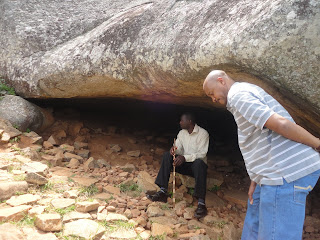Crossing the border (ZIM/SA) was not as horrible as we were warned as we left before the Easter holiday return of Zimbabweans from SA.
The journey was quite pleasant until we were about 40 minutes from our hotel and the GPS directed us onto a very bad road! Alas, we got a puncture. To cut a long story short, some good Samaritans helped us and we were on our way. Trying to get the tyre patched the next day was a trip. First we found a tyre shop and the man told us they had no electricity the day before and there is none now so we decided to use the donut to go see the Ruins of Great Zimbabwe. On our return electricity had come back and he spent quite a while with his machine trying to patch it at the price tag of US$8. Ok, so he says it's done now but when I looked at it I knew it wasn't done properly. I said to John to take it around the block to see if it will hope. Surprise - it didn't! So the quest to find a tyre began.
The tyre man told us we would not get Michelin tyres in ZIM as they are too expensive and the best we can get at this time (around 5.30pm) would be a second hand tyre. After haggling in a local market we got one for US$28.
That was the drama of the trip. We had a lovely time visiting Great Zimbabwe (the national monument from which the country takes its name) and Victoria Falls.
Great Zimbabwe
The Great Zimbabwe Ruins are one of the most important archaeological sites in Africa, giving testimony to the lost civilisation of the Shona.
A great city existed here from the 11th century on, with over 10.000 inhabitants. Great Zimbabwe (“stone houses”) was a main regional trading center, its wealth associated with (Arab) gold trading. There were also trade links with East Africa (Kilwa), and fragments of Persian and Chinese pottery has been found at the site.
Arab and European travellers in the 16th century sent marvelling reports home about this place and its impressive stone walls. The site was abandoned in the 15th century (for Khami) because of a lack of food and firewood.
The ruins nowadays are spread out over three main areas: the Hill Ruins, the Great Enclosure and the Valley Ruins (taken from World Heritage Site).
A great city existed here from the 11th century on, with over 10.000 inhabitants. Great Zimbabwe (“stone houses”) was a main regional trading center, its wealth associated with (Arab) gold trading. There were also trade links with East Africa (Kilwa), and fragments of Persian and Chinese pottery has been found at the site.
Arab and European travellers in the 16th century sent marvelling reports home about this place and its impressive stone walls. The site was abandoned in the 15th century (for Khami) because of a lack of food and firewood.
The ruins nowadays are spread out over three main areas: the Hill Ruins, the Great Enclosure and the Valley Ruins (taken from World Heritage Site).
 |
| The road to Masvingo |
 |
| A toll plaza |
 |
| John and our able tour guide Ananias |
 |
| The ruins high above. It is not a climb for the weary! |
 |
| This stone allows for an amazing echo down to plateau (where the commoners lived). |
 |
| Very narrow pathways at some points |
 |
| Replica of a Shona house |
 |
| Shona people who danced for us |
Elephants at the watering hole at our hotel in Victoria Falls
Baboons on the journey to Vic Falls - a lot of them even in the streets!
Victoria Falls - one of the seven natural wonders of the world
The Victoria Falls constitutes one of the most spectacular natural wonders of the world. The Local people call it "Mosi-oa-Tunya" -- the smoke that thunders and the Falls are remarkable.
There is a magic about them manifested in the towering column of spray when the river is high, the thunder of the falling water, the terrifying abyss and tranquil lagoons upstream in which hippo and deadly crocodiles lurk.
The Victoria falls is 1 708 meters wide, making it the largest curtain of water in the world. It drops between 90m and 107m into the Zambezi Gorge and an average of 550,000 cubic metres of water plummet over the edge every minute (taken from SA Places).
Our stay at the Ancient Lodge was better that we expected and would recommend it for anyone going that side.


























































